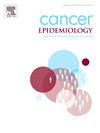Unraveling the role of adjuvant chemotherapy in elderly triple-negative breast cancer: Insights from competing risk analysis using SEER data
IF 2.3
3区 医学
Q3 ONCOLOGY
引用次数: 0
Abstract
Background
Triple-negative breast cancer (TNBC) is an aggressive subtype with poor outcomes, especially in elderly patients. While chemotherapy is the main systemic treatment, its survival benefits for Patients with TNBC aged ≥ 70 years remain unclear due to comorbidities and treatment intolerance. This study assessed the impact of adjuvant chemotherapy on survival outcomes using competing risk analysis.
Methods
A cohort of 4855 elderly Patients with TNBC (≥70 years) was extracted from the SEER database (2010–2016). Propensity score matching (PSM) balanced baseline characteristics between chemotherapy and non-chemotherapy groups. Survival analyses were performed both in the unmatched cohort and in the matched cohort after PSM. For the construction of the nomogram, the full cohort was randomly divided into a training set (70 %) and a validation set (30 %) for internal validation. Overall survival (OS), breast cancer-specific survival (BCSS), and competing risks of breast cancer-specific death (BCSD) and other-cause death (OCD) were analyzed using Kaplan-Meier and Fine-Gray models. A nomogram was developed to predict individualized survival outcomes.
Results
The median follow-up time was 62 months, during which 991 BCSD events and 1120 OCD events were recorded. After PSM, the 5-year OS rate was 74.2 % in the chemotherapy group and 62.4 % in the non-chemotherapy group (p < 0.05). After PSM, chemotherapy significantly improved OS (p < 0.05) but did not reduce 5-year BCSD (17.42 % vs. 18.47 %, p = 0.659). However, chemotherapy decreased 5-year OCD (9.39 % vs. 17.54 %, p < 0.001). In the full cohort training set, independent predictors of BCSD included tumor grade, radiation therapy, T category, and N category. The nomogram showed high accuracy (AUC: 1-year = 0.822, 3-year = 0.773, 5-year = 0.745) and excellent calibration.
Conclusion
Adjuvant chemotherapy significantly was associated with OCD, indirectly improving OS, but has limited direct impact on BCSD in elderly Patients with TNBC. Competing risk analysis highlights the importance of individualized treatment strategies. The validated nomogram provides a practical tool for precision medicine. Future research should explore biological mechanisms and validate these findings in multi-regional cohorts.
揭示辅助化疗在老年三阴性乳腺癌中的作用:来自SEER数据竞争风险分析的见解
背景:三阴性乳腺癌(TNBC)是一种预后较差的侵袭性亚型,尤其是在老年患者中。虽然化疗是主要的全身治疗,但由于合并症和治疗不耐受,其对年龄≥ 70岁TNBC患者的生存益处尚不清楚。本研究使用竞争风险分析评估了辅助化疗对生存结果的影响。方法从SEER数据库(2010-2016)中提取4855例老年TNBC患者(≥70岁)。倾向评分匹配(PSM)平衡了化疗组和非化疗组之间的基线特征。在PSM后,对未匹配队列和匹配队列进行生存分析。为了构建nomogram,将整个队列随机分为训练集(70 %)和验证集(30 %)进行内部验证。使用Kaplan-Meier和Fine-Gray模型分析总生存率(OS)、乳腺癌特异性生存率(BCSS)以及乳腺癌特异性死亡(BCSD)和其他原因死亡(OCD)的竞争风险。开发了一种nomogram预测个体化生存结果。结果中位随访62个月,共记录BCSD事件991例,OCD事件1120例。PSM后化疗组5年OS为74.2 %,非化疗组为62.4 % (p <; 0.05)。PSM后化疗显著改善OS (p <; 0.05),但未降低5年BCSD(17.42 % vs. 18.47 %,p = 0.659)。然而,化疗降低了5年强迫症(9.39 % vs. 17.54 %,p <; 0.001)。在全队列训练集中,BCSD的独立预测因子包括肿瘤分级、放疗、T类和N类。nomogram准确度高(AUC: 1年= 0.822,3年= 0.773,5年= 0.745),校正效果好。结论辅助化疗与老年TNBC患者的OCD显著相关,可间接改善OS,但对BCSD的直接影响有限。竞争风险分析强调了个性化治疗策略的重要性。验证后的图为精准医疗提供了实用的工具。未来的研究应探索生物学机制,并在多地区队列中验证这些发现。
本文章由计算机程序翻译,如有差异,请以英文原文为准。
求助全文
约1分钟内获得全文
求助全文
来源期刊

Cancer Epidemiology
医学-肿瘤学
CiteScore
4.50
自引率
3.80%
发文量
200
审稿时长
39 days
期刊介绍:
Cancer Epidemiology is dedicated to increasing understanding about cancer causes, prevention and control. The scope of the journal embraces all aspects of cancer epidemiology including:
• Descriptive epidemiology
• Studies of risk factors for disease initiation, development and prognosis
• Screening and early detection
• Prevention and control
• Methodological issues
The journal publishes original research articles (full length and short reports), systematic reviews and meta-analyses, editorials, commentaries and letters to the editor commenting on previously published research.
 求助内容:
求助内容: 应助结果提醒方式:
应助结果提醒方式:


